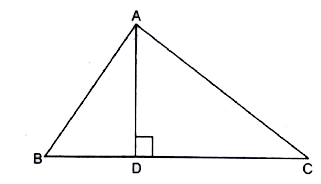In the adjacent figure ∠BAC=90∘andAD⊥BC then

A
BD⋅CD=BC2
B
AB.AC=BC2
C
BD⋅CD=AD2
D
AB⋅AC=AD2
Text Solution
The correct Answer is:C
|
Topper's Solved these Questions
- GEOMETRYBOOK - NCERT TAMILCHAPTER - GEOMETRYEXERCISE - UNIT EXERCISE - 4
5 Videos
- GEOMETRYBOOK - NCERT TAMILCHAPTER - GEOMETRYEXERCISE - EXERCISE 4.4
12 Videos
- COORDINATE GEOMETRY BOOK - NCERT TAMILCHAPTER - COORDINATE GEOMETRY EXERCISE - TRY THIS
15 Videos
- MENSURATIONBOOK - NCERT TAMILCHAPTER - MENSURATIONEXERCISE - Unit Exercise - 7
10 Videos
Similar Questions
Knowledge Check
In figure, if ∠BAC=90∘ and AD⊥BC. Then,
 ABD.CD=BC2BAB⋅AC=BC2CBD⋅CD=AD2DAB⋅AC=AD2
ABD.CD=BC2BAB⋅AC=BC2CBD⋅CD=AD2DAB⋅AC=AD2In the figure, if ∠BAC=90∘ and AD⊥BC, then:
 ABD.CD=BC2BAB.AC=BC2CBD.CD=AD2DAB.AC=AD2
ABD.CD=BC2BAB.AC=BC2CBD.CD=AD2DAB.AC=AD2In the figure given below ∠BAC=90∘ and AD ⊥ BC. Then
 ABC×CD=AC2BAB×AC=BC2CBD×CD=AD2DAB×AC=AD2
ABC×CD=AC2BAB×AC=BC2CBD×CD=AD2DAB×AC=AD2
In the given figure, ∠CAB=90∘andAD⊥BC. Show that ΔBDA~ΔBAC. if AC=75cm,AB=1mandBC=1.25cm, find AD.

View SolutionIn the given figure ∠ABC=90∘andCD⊥AB. Prove that BC2AC2=BDAD

View Solutionin the given figure ∠CAB=90∘andAD⊥BC. if AC= 75 cm , AB= 1m and BD= 1.25 m . Find AD.

View Solutionin the given figure ∠CAB=90∘andAD⊥BC. if AC= 75 cm , AB= 1m and BD= 1.25 m . Find AD.

View SolutionIn the given figure, ∠ABC=90∘andBD⊥AC. If BD=8cm,AD=4cm find CD.

View Solution

